Sony LBT-ZX9 User Manual
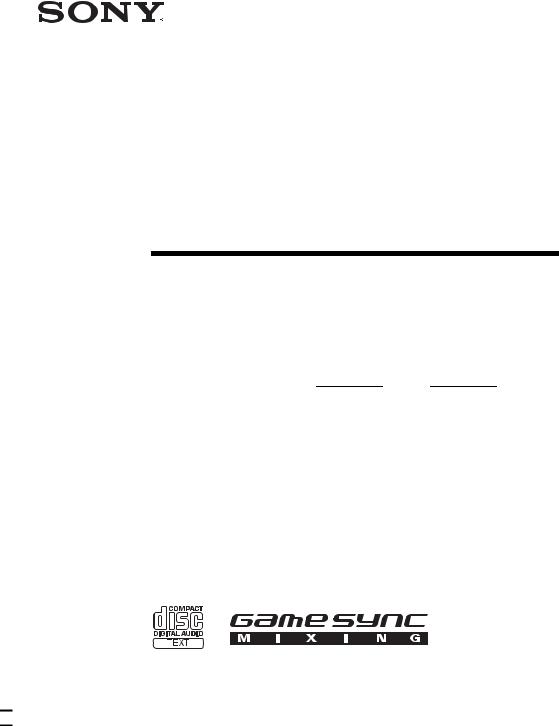
2-694-377-21(1)
Compact
Hi-Fi Stereo
System
Operating Instructions
Owner’s Record
The model and serial numbers are located on the rear of the unit. Record the serial number in the space provided below. Refer to them whenever you call upon your Sony dealer regarding this product.
Model No. Serial No.
LBT-ZX9
©2007 Sony Corporation
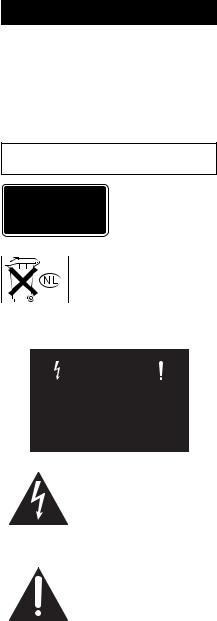
WARNING
To reduce the risk of fire or electric shock, do not expose this apparatus to rain or moisture.
To prevent fire, do not cover the ventilation of the apparatus with newspapers, table-cloths, curtains, etc. And don’t place lighted candles on the apparatus.
To prevent fire or shock hazard, do not place objects filled with liquids, such as vases, on the apparatus.
Do not install the appliance in a confined space, such as a bookcase or built-in cabinet.
This appliance is classified as a CLASS 1 LASER product. This label is located on the rear exterior.
Don’t throw away the battery with general house waste, dispose of it correctly as chemical waste.
NOTICE FOR THE CUSTOMERS IN THE U.S.A.
This symbol is intended to alert the user to the presence of uninsulated “dangerous voltage” within the product’s enclosure that may be of sufficient magnitude to constitute a risk of electric shock to persons.
This symbol is intended to alert the user to the presence of important operating and maintenance (servicing) instructions in the literature accompanying the appliance.
WARNING
This equipment has been tested and found to comply with the limits for a Class B digital device, pursuant to Part 15 of the FCC Rules. These limits are designed to provide reasonable protection against harmful interference in a residential installation. This equipment generates, uses, and can radiate radio frequency energy and, if not installed and used in accordance with the instructions, may cause harmful interference to radio communications. However, there is no guarantee that interference will not occur in a particular installation. If this equipment does cause harmful interference to radio or television reception, which can be determined by turning the equipment off and on, the user is encouraged to try to correct the interference by one or more of the following measures:
–Reorient or relocate the receiving antenna.
–Increase the separation between the equipment and receiver.
–Connect the equipment into an outlet on a circuit different from that to which the receiver is connected.
–Consult the dealer or an experienced radio/TV technician for help.
CAUTION
You are cautioned that any changes or modification not expressly approved in this manual could void your authority to operate this equipment.
Note to CATV system installer:
This reminder is provided to call CATV system installer’s attention to Article 820-40 of the NEC that provides guidelines for proper grounding and, in particular, specifies that the cable ground shall be connected to the grounding system of the building, as close to the point of cable entry as practical.
2US
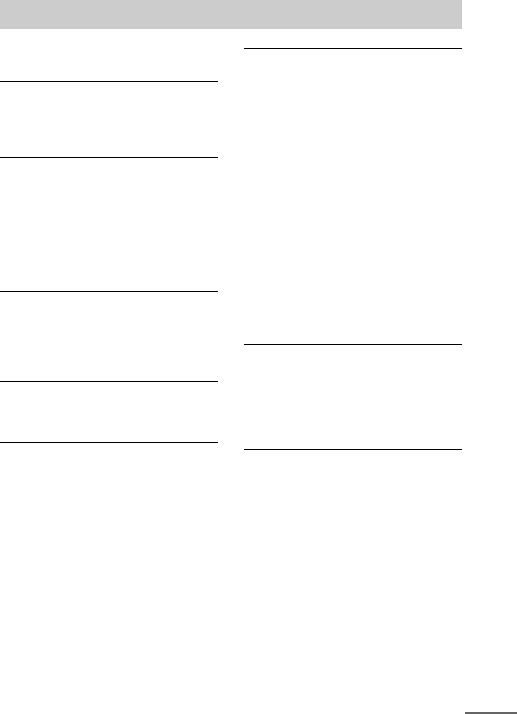
Table of Contents |
|
About this manual ................................... |
5 |
Playable discs.......................................... |
5 |
Getting Started |
|
Hooking up the system............................ |
7 |
Positioning the speakers.......................... |
9 |
Setting the clock...................................... |
9 |
CD/MP3 |
|
Loading a disc ....................................... |
10 |
Playing a disc ........................................ |
10 |
— Normal Play/Shuffle Play |
|
Playing repeatedly................................. |
11 |
— Repeat Play |
|
Creating your own program .................. |
12 |
— Program Play |
|
Tuner |
|
Presetting radio stations ........................ |
13 |
Listening to the radio ............................ |
14 |
— Preset Tuning |
|
— Manual Tuning |
|
Tape |
|
Loading a tape....................................... |
15 |
Playing a tape ........................................ |
15 |
Tape – Recording |
|
Recording your favorite tracks on a |
|
disc into a tape ................................ |
16 |
— CD Synchro Recording |
|
— Program Edit |
|
Recording to a tape manually ............... |
17 |
— Manual Recording |
|
Sound Adjustment |
|
Adjusting the sound .............................. |
18 |
Selecting the preset effect..................... |
18 |
Adjusting the graphic equalizer and |
|
storing the personal file .................. |
18 |
Selecting the surround effect ................ |
19 |
Selecting the MP3 Booster effect ......... |
19 |
Creating a party environment ............... |
19 |
— X-ROUND |
|
— FLASH |
|
Listening to the sound in another |
|
room ............................................... |
20 |
— Multi Room |
|
Enhancing the video game sound ......... |
21 |
— Game Sync |
|
Mixing video game sound with other |
|
sound source ................................... |
21 |
— Game Mixing |
|
Singing along ........................................ |
21 |
Timer |
|
Falling asleep to music ......................... |
22 |
— Sleep Timer |
|
Waking up to music .............................. |
22 |
— Play Timer |
|
Timer recording radio programs........... |
23 |
Display |
|
Turning off the display ......................... |
24 |
— Power Saving Mode |
|
Viewing information about the disc |
|
in the display .................................. |
25 |
Changing the power illuminator ........... |
26 |
Changing the spectrum analyzer |
|
display ............................................ |
26 |
Adjusting the brightness of the |
|
display ............................................ |
26 |
continued
3US
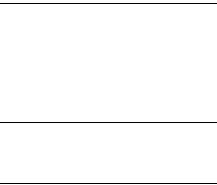
Optional Components |
|
Hooking up optional components ......... |
27 |
Listening to audio from a connected |
|
component ...................................... |
28 |
Recording on a connected |
|
component ...................................... |
29 |
Connecting external antennas ............... |
29 |
Troubleshooting |
|
Problems and remedies ......................... |
30 |
Messages ............................................... |
33 |
Additional Information |
|
Precautions ............................................ |
34 |
Specifications ........................................ |
35 |
List of button locations and reference |
|
pages ............................................... |
37 |
4US

About this manual
This manual mainly explains operations using the buttons on the system, but the same operations can also be performed using the buttons on the remote having the same or similar names.
The LBT-ZX9 consists of the following components:
– |
Tuner/CD/MP3 player/Stereo cassette |
|
|
deck/Amplifier (main unit) |
HCD-ZX9 |
– |
Speaker System |
|
|
• Front/Surround speakers |
SS-ZX9 |
Playable discs
You can playback the following discs on this system. The other discs cannot be played back.
List of playable discs
Format of |
Disc logo |
Contents |
|
discs |
|||
|
|
||
|
|
|
|
Audio CDs |
|
Audio |
CD-R/CD-RW 






 Audio
Audio
(Audio CDs)
CD-R/CD-RW 






 Audio (Discs with
Audio (Discs with
MP3 audio tracks)
Discs that this system cannot play
•A disc that has a non-standard shape (e.g., card, heart).
•A disc that has the adhesive, cellophone tape, or a sticker still left on it.
•Discs other than the following:
–Audio CDs.
–CD-Rs/CD-RWs that recorded in the Audio CD format.
–CD-Rs/CD-RWs and CD-ROMs that has MP3 audio tracks those format that conforms to ISO 9660*1 Level 1, Level 2, Joliet in expansion format or Multi Session*2. MP3 audio tracks must be in MPEG 1, 2, 2.5 Audio Layer 3 format.
•Data part of CD-Extras*3.
•Data part of Mixed CDs*4.
•Audio side of a DualDisc.
*1 ISO 9660 Format
The most common international standard for the logical format of files and folders on a CD-ROM. There are several specification levels. In Level 1, file names must be in the 8.3 format (no more than eight characters in the name, no more than three characters in the extension “.MP3”) and in capital letters. Folder names can be no longer than eight characters. There can be no more than eight nested folder levels. Level 2 specifications allow file names and folder names up to 31 characters long. Each folder can have up to 8 trees.
For Joliet or Romeo in the expansion format, make sure of the contents of the writting software, etc.
*2 Multi Session
This is a recording method that enables adding of data using the Track-At-Once method. Conventional discs begin at a disc control area called the Lead-in and end at an area called Lead-out. A Multi Sessions disc is a disc having multiple sessions, with each segment from Lead-in to Leadout regarded as a single session.
*3 CD-Extra
This format records audio (audio CD data) on the tracks in session 1 and data on the tracks in session 2.
*4 Mixed CD
This format records data on the first track and audio (audio CD data) on the second and subsequent tracks of a session.
continued
5US
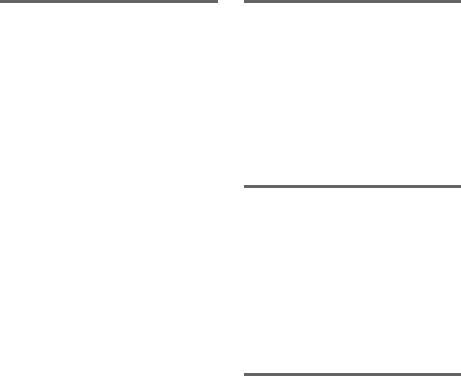
Notes on discs
•This system can play CD-R/CD-RW discs edited by the user. However, note that playback of some discs may not be possible depending on the recording device used for recording or the disc condition.
•Discs recorded on CD-R/CD-RW drives may not be played back because of scratches, dirt, recording condition or the driver’s characteristics.
•CD-R and CD-RW discs that have not been finalized (processing to allow playback by a normal disc player) cannot be played back.
•CD-R and CD-RW discs recorded in Multi Session that have not ended by “closing the session” are not supported.
•The system may be unable to playback MP3 format files that do not have the extension “.MP3”.
•Attempting to playback non-MP3 format files that have the extension “.MP3” may result in noise or malfunction.
•With format other than ISO 9660 Level 1, Level 2 or Joliet in expansion format, album titles or track titles may not be displayed correctly.
•The following discs take a longer time to start playback.
–a disc recorded with complicated tree structure.
–a disc recorded in Multi Session.
–a disc to which data can be added (nonfinalized disc).
•CD-RWs that recorded in packet write format cannot be played back.
Note on DualDiscs
This product is designed to play back discs that conform to the Compact Disc (CD) standard. A DualDisc is a two sided disc product which mates DVD recorded material on one side with digital audio material on the other side. Please be aware that the audio side of a DualDisc may not be played back on this product because these discs do not conform to the CD standard. “DualDisc” is a trademark of the Recording Industry Association of America (RIAA).
Music discs encoded with copyright protection technologies
This product is designed to playback discs that conform to the Compact Disc (CD) standard. Recently, various music discs encoded with copyright protection technologies are marketed by some record companies. Please be aware that among those discs, there are some that do not conform to the CD standard and may not be playable by this product.
Cautions when playing a disc that is recorded in Multi Session
•This system can play Multi Session discs when an MP3 audio track is contained in the first session. Any subsequent MP3 audio tracks recorded in later sessions can also be played back.
•When you play Multi Session discs with different formats for each session, the format of the first session is recognized as the disc type. Tracks in the second and subsequent sessions are played if they are the same formats as the first session.
6US
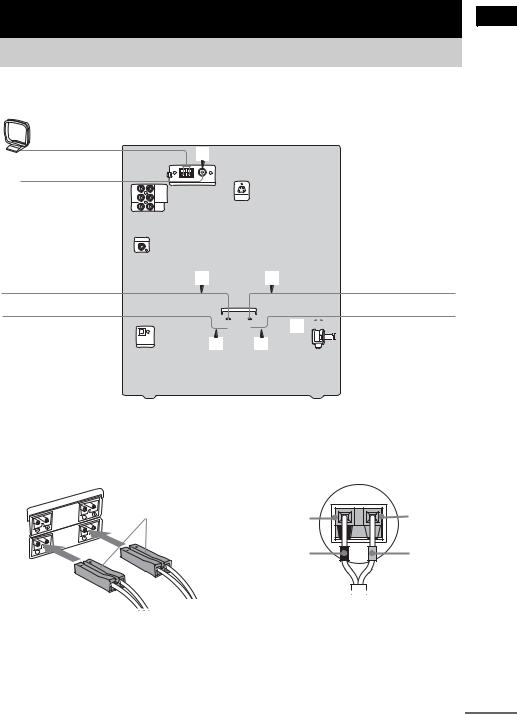
Getting Started
Hooking up the system
Do the following procedures 1 to 4 to hook up your system using the supplied cords and accessories (page 36).
AM loop antenna
 3
3
FM lead antenna
Started Getting
To surround speaker (right)
To front speaker (right)
22
 4
4
 1 1
1 1
To surround speaker (left)
To front speaker (left)
1 Connect the front speakers. |
Tip |
Connect the speaker cords to the FRONT |
Connect the speaker cords to the terminals on the |
SPEAKER (SPEAKER A) terminals. |
speakers. |
|
SP |
EA |
KE |
R |
|
|
|
|||
|
|
L |
||
|
|
|
|
|
R |
SURROUNDB) |
|||
(SPEAKER |
|
|||
|
|
|
|
L |
R |
|
FRONT A) |
||
|
|
|||
|
(SPEAKER |
|
||
White |
Black (#) |
Red (3) |
|
||
|
Black (#) |
Red (3) |
continued
7US
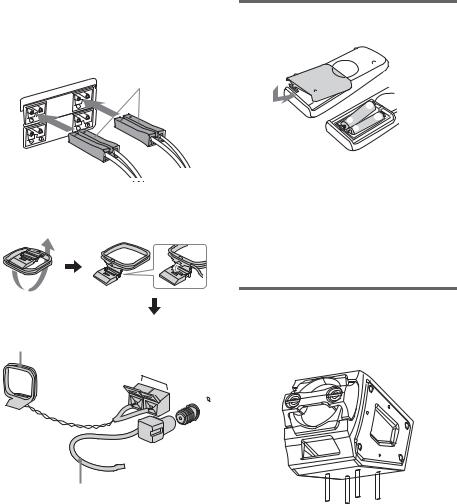
2Connect the surround speakers.
Connect the speaker cords to the SURROUND SPEAKER (SPEAKER B) terminals and to the terminals on the speakers as shown in the tip above.
Grey
SP |
EA |
KE |
R |
|
|
|
|||
|
|
L |
||
|
|
|
|
|
R |
SURROUNDB) |
|||
(SPEAKER |
|
|||
|
|
|
|
L |
R |
|
FRONT A) |
||
|
|
|||
|
(SPEAKER |
|
||
3Connect the FM and AM antennas.
Set up the AM loop antenna, then connect
it.
Inserting two R6 (size AA) batteries into the remote
|
e |
E |
E |
|
|
e |
|
Note
If you do not use the remote for a long period of time, remove the batteries to avoid possible damage from battery leakage and corrosion.
Tip
With normal use, the batteries should last for about six months. When the remote no longer operates the system, replace both batteries with new ones.
AM loop antenna
Attaching the speaker pads
Attach the supplied speaker pads to the bottom of the speakers to stabilize the speakers and prevent them from slipping.
AM
FM75
COAXIAL
Extend the FM lead antenna horizontally
4Connect the power cord to a wall outlet.
The demonstration appears in the display. When you press ?/1, the system turns on and the demonstration automatically ends.
Notes
•Keep the speaker cords away from the antennas to prevent noise.
•Be sure to match the color of the speaker terminals on the system and the connectors.
•Be sure to connect the speakers securely and correctly.
8US
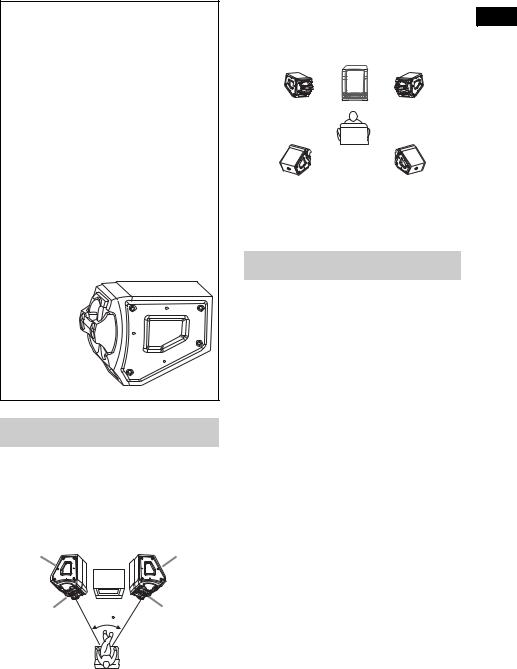
Notice for carrying this system
Do the following procedure to protect the disc mechanism. Use buttons on the system for the operation.
1Press ?/1 to turn on the system.
2Make sure that all discs are removed from the system.
3Hold down REPEAT and then press ?/1 until “LOCK” appears in the display.
4Release ?/1 first, then release REPEAT.
5Unplug the power cord.
When carrying the front and surround speakers
Do not carry the front and surround speakers by their sub panel. Otherwise, the speakers may be damaged.
Sub panel 
Positioning the speakers
There are 3 ways to place the front speakers and the surround speakers.
Example 1: Place the surround speakers on the top of the front speakers as shown below.
Surround |
Main Unit |
Surround |
Speaker (L) |
Speaker (R) |
Front |
45 |
Front |
|
Speaker (L) |
Speaker (R) |
||
|
|||
|
Listener |
|
Example 2: Place the speakers at an equal distance from your listening position as shown below.
Front |
Main Unit |
Front |
||
Speaker (L) |
|
|
|
Speaker (R) |
|
|
|
|
|
|
|
|
|
|
|
|
|
|
|
|
Listener |
Surround |
Surround |
Speaker (L) |
Speaker (R) |
Example 3: Place the front speakers in one room and the surround speakers in another room.
Setting the clock
1 Press ?/1 to turn on the system.
2 Press CLOCK/TIMER SET.
“CLOCK” appears in the display. Then, the hour indication flashes in the display.
3 Press M or m (or >+ or –. on the remote) repeatedly to set the hour.
4 Press ENTER.
The minute indication flashes in the display.
5 Press M or m (or >+ or –. on the remote) repeatedly to set the minute.
6 Press ENTER.
The clock starts functioning.
To adjust the clock
1Press CLOCK/TIMER SET.
“PLAY SET?” flashes in the display.
2Press M or m (or >+ or –. on the remote) to select “CLOCK SET?”, then press ENTER.
The hour indication flashes in the display.
3Do the same procedures as step 3 to 6 above.
Note
The clock settings are canceled when you disconnect the power cord or if a power failure occurs.
Started Getting
9US
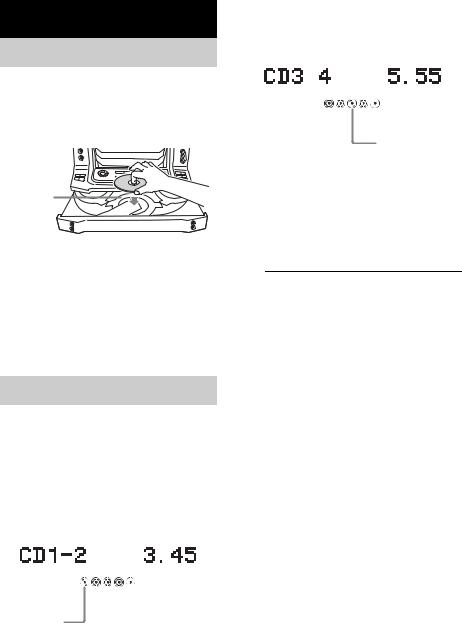
CD/MP3
Loading a disc
1 Press Z OPEN/CLOSE.
The disc tray slides out.
2 Place a disc with the label side facing up on the disc tray.
When you play a CD single, place it on the inner circle of the tray
To load additional discs, press DISC SKIP to rotate the disc tray.
3 Press Z OPEN/CLOSE to close the disc tray.
Note
Do not push the disc tray when closing it as this may cause malfunction. Press Z OPEN/CLOSE to close the disc tray.
Playing a disc
— Normal Play/Shuffle Play
This system lets you play audio CDs and discs with MP3 audio tracks in different play modes.
When playing an audio CD:
Disc tray |
Track number |
|
Playing time |
||||||||||
number |
|
||||||||||||
|
|
|
|
|
|
|
|
|
|
|
|
|
|
|
|
|
|
|
|
|
ALL |
DISC S |
|
|
|
|
|
|
|
|
|
|
|
|
|
|
|
|
|||
|
|
|
|
|
|
|
|
|
|
|
|||
|
|
|
|
1 |
2 |
3 |
4 |
5 |
|
|
|
||
EFFECT |
|
|
|
j |
|
|
|
|
|
|
|||
|
|
|
|
|
|
|
|
|
|||||
X-GROOVE |
|
|
|
|
|
|
|
|
|
|
|||
|
|
|
|
|
|
|
|
|
|
|
|
|
|
Disc playing |
|
|
|
|
|
|
|
|
|
|
|||
|
|
|
Disc presence indicator |
||||||||||
indicator |
|
|
|
||||||||||
|
|
|
|
|
|
|
|
|
|
||||
When playing an MP3 audio track:
|
Disc tray |
Track number |
|
Playing time |
||||||||||
|
number |
|
||||||||||||
|
|
|
|
|
|
|
|
|
|
|
|
|
|
|
|
|
|
|
|
|
|
|
|
|
|
|
|
|
|
|
|
|
|
|
|
|
|
|
|
|
|
|
|
|
|
|
|
|
|
|
|
|
|
|
|
|
|
|
|
|
ID3 |
|
|
|
|
MP3 |
|
|
|
|
|
|||
|
|
|
|
|
|
|
|
ALL |
DISC S |
|
|
|
|
|
|
|
|
|
|
1 |
2 |
3 |
4 |
5 |
|
|
|
||
|
EFFECT |
|
|
|
j |
|
|
|
|
|
||||
|
|
|
|
|
|
|
|
|
||||||
|
X-GROOVE |
|
|
|
|
|
|
|
|
|
|
|||
|
|
|
|
|
|
|
|
|
|
|
|
|
|
|
|
|
|
|
|
|
|
|
|
|
|
|
Disc playing |
||
Disc presence indicator |
|
|
|
|||||||||||
|
|
|
indicator |
|||||||||||
|
|
|
|
|
|
|
|
|
|
|
|
|||
1 Press FUNCTION repeatedly until “CD” appears in the display (or press CD on the remote).
2 When the playback is stopped, press PLAY MODE repeatedly until the indication of the play mode you want appears in the display.
Select |
To play |
ALL DISCS |
The tracks on all discs in the |
(Normal Play) |
disc tray continuously. |
|
|
1 DISC |
The tracks on the disc you |
(Normal Play) |
have selected in original |
|
order. |
|
|
ALBM |
All MP3 audio tracks in the |
(Normal Play) |
album on the disc you have |
|
selected in original order. |
|
When playing an audio CD, |
|
“ALBM” play mode |
|
performs the same operation |
|
as “1 DISC” play mode. |
|
|
ALL DISCS |
The tracks on all discs in |
SHUF |
random order. |
(Shuffle Play) |
|
|
|
1 DISC SHUF |
The tracks on the disc you |
(Shuffle Play) |
have selected in random |
|
order. |
|
|
ALBM SHUF |
The MP3 audio tracks in the |
(Shuffle Play) |
album on the disc you have |
|
selected in random order. |
|
When playing an audio CD, |
|
“ALBM SHUF” play mode |
|
performs the same operation |
|
as “1 DISC SHUF” play |
|
mode. |
|
|
PGM |
The tracks on all discs in the |
(Program Play) |
order you want them to be |
|
played back (see “Creating |
|
your own program” on |
|
page 12). |
|
|
10US

3 Press NX (or N on the remote).
NX indicator lights up.
Tips
•You cannot change the play mode during playback. To change the play mode, press x to stop playback.
•When an MP3 audio track with ID3 tag is played back, “ID3” lights up in the display.
•When the current disc is a disc with MP3 audio tracks, “MP3” lights up in the display.
Other operations
To |
Do this |
Stop playback |
Press x. |
|
|
Pause playback |
Press NX (or X on the remote). |
|
Press again to resume playback. |
|
|
Select a track |
Press . or > (or –. or |
|
>+ on the remote) repeatedly. |
|
|
Select an album |
Press ALBUM +/–. |
of MP3 audio |
|
tracks |
|
|
|
Find a point in a |
Press and hold down m or M |
track*1 |
during playback and release it at |
|
the point you want to resume |
|
playback. Use button on the |
|
remote for this operation while |
|
playing an MP3 audio track. |
|
|
Select a disc |
Press one of the DISC 1 ~ 5 |
|
buttons or DISC SKIP. |
|
|
Switch to CD |
Press one of the DISC 1 ~ 5 |
function from |
buttons or NX (Automatic |
another source |
Source Selection). |
and start |
|
playback |
|
automatically.*2 |
|
Exchange other |
Press EX-CHANGE. The disc tray |
discs while |
slides out. Then press DISC SKIP |
playing |
to select the disc you want to |
|
exchange. |
|
|
Remove the disc |
Press Z OPEN/CLOSE. |
|
|
*1 The playing time may not be displayed correctly depending on the MP3 audio tracks.
*2 Only when there is a disc in disc tray.
Notes
•This system can playback MP3 audio tracks in the format of MPEG 1 Audio Layer 3, MPEG 2 Audio Layer 3 and MPEG 2.5 Audio Layer 3.
•This system can playback Multi Session discs when an MP3 audio track is located in the first session. Any subsequent MP3 audio tracks, recorded in the later sessions, can also be played back.
•When naming the MP3 audio tracks, be sure to add the file extension “.MP3” to the file name.
•If you save up the extension “.MP3” to a track other than MP3 audio tracks, the system cannot recognize the track properly and will generate random noise that could damage your speakers.
•You are recommended not to save other type of tracks or unneccessary album on a disc that has MP3 audio tracks.
•The disc recorded with complicated tree structure takes a longer time to start playback.
•When the disc is loaded, the system reads all the tracks in that disc. If there are many albums or non MP3 audio tracks on the disc, it may take a longer time for playback to begin or for the next MP3 audio track to start playback.
•An album that does not include an MP3 audio track is skipped.
•The maximum number of albums on a disc which can be recognize by this system is 150 (including root album).
•The maximum number of MP3 audio tracks and albums on a disc which can be recognize by this system is 300.
•Depending on the encoding/writing software, recording device, or the recording media used at the time an MP3 audio track is recorded, you may encounter problems such as cannot playback, sound interruptions, and noise.
Tips
•When switching to “CD” function from “TUNER” function by pressing NX, a longer time may be required to access the disc. In this case, set “CD POWER ON” by CD power manage function (page 14).
•If you press NX while the system is turned off, the system turns on automatically and “CD” is selected as a function. Then, playback starts if there is a disc in the disc tray (One Touch Play).
•If you press CD on the remote while the system is turned off, the system turns on automatically and “CD” is selected as a function.
Playing repeatedly
— Repeat Play
You can playback all the tracks or a single track on a disc repeatedly.
continued
CD/MP3 |
11US
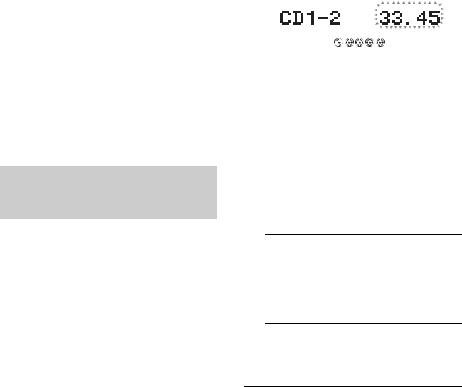
Press REPEAT repeatedly until “REP” or “REP1” lights up in the display.
REP: All the tracks on the disc, or all the tracks in the album* are played back repeatedly up to five times.
REP1: A single track is played back repeatedly until “REP1” is canceled.
*When “ALBM” or “ALBM SHUF” is selected for MP3 audio tracks.
To cancel Repeat Play
Press REPEAT repeatedly until both “REP” and “REP1” disappear from the display.
Note
You cannot select “REP” and “ALL DISCS SHUF” at the same time.
Creating your own program
— Program Play
You can make a program of up to 25 steps from all the discs in the order you want to play them. You can synchro record the programmed tracks onto a tape (page 16).
1 Press FUNCTION repeatedly until “CD” appears in the display (or press CD on the remote).
2 Press PLAY MODE in stop mode repeatedly until “PGM” lights up in the display.
3 Press one of DISC 1 ~ 5 buttons or DISC SKIP to select a disc.
To program all the tracks on a disc at once, proceed to step 5 while “AL” appears in the display.
To program all the MP3 audio tracks on an album at once, press ALBUM +/– repeatedly until the album you want appears in the display, then proceed to step 5.
4 Press . or > (or –. or >+ on the remote) repeatedly until the track number you want appears in the display.
The total playing time flashes in the display.
|
|
|
|
|
|
|
|
|
|
|
|
|
|
|
Total playing |
|||
Disc tray |
Track |
|
|
|
time (including |
|||||||||||||
number |
number |
|
|
selected track) |
||||||||||||||
|
|
|
|
|
|
|
|
|
|
|
|
|
|
|
|
|
|
|
|
|
|
|
|
|
|
|
|
|
|
|
|
|
|
|
|
|
|
|
|
|
|
|
|
|
|
|
|
|
|
PGM |
|
|
|
|
|
|
|
|
|
|
|
|
1 |
2 |
3 |
4 |
5 |
|
|
|
|||||
EFFECT |
|
|
|
|
|
j |
|
|
|
|
|
|
|
|||||
X-GROOVE |
|
|
|
|
|
|
|
|
|
|
|
|
|
|||||
|
|
|
|
|
|
|
|
|
|
|
|
|
|
|
|
|
|
|
When programming an MP3 audio track, press ALBUM +/– to select album, then press . or > (or –. or >+ on the remote) repeatedly until the track number you want appears in the display.
5 Press PLAY MODE.
The track(s) is (are) programmed. The program step number appears, followed by total playing time.
6 Program additional discs or tracks.
To program |
Repeat steps |
Other discs |
3 and 5 |
|
|
Other tracks on the |
4 and 5 |
same disc |
|
|
|
Other tracks on |
3 to 5 |
other discs |
|
7 Press NX (or N on the remote).
Program Play starts.
Other operations
To |
Do this |
Cancel Program |
Press PLAY MODE repeatedly |
Play |
until “PGM” disappears from the |
|
display. |
|
|
Clear a track from |
Press CLEAR on the remote |
the end |
when the playback is stopped. |
|
|
Tips
•The program you made remains in the system’s memory even after it has been played back. Press NX (or N on the remote) to play the same program again.
•If “--.--” appears instead of the total playing time during programming, this means:
–you have programmed a track number which exceeds 20.
–the total playing time has exceeded 100 minutes.
–you have programmed an MP3 audio track.
12US
